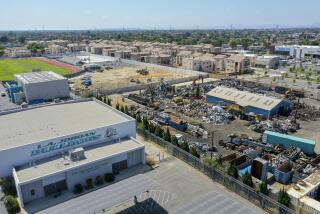Defense Firm Uncovers Computer ‘Logic Bomb’ : Hacking: Ex-General Dynamics worker from San Diego is accused of trying to destroy Atlas information.
- Share via
SAN DIEGO — A disgruntled General Dynamics computer programmer, hoping to increase his salary by creating a problem only he could solve, allegedly planted a computer “logic bomb” that could have destroyed vital data in the San Diego defense contractor’s Atlas Rocket space program, according to a federal indictment unsealed Tuesday.
Federal officials allege that Michael J. Lauffenburger, 31, created a program he named “Cleanup” that was designed to destroy a database of Atlas Rocket component parts, delete another set of programs used to respond to governmental requests and then delete itself, without leaving a trace.
Had it been allowed to do its work, the program would have impaired the company’s ability to report its progress to the federal government as required under its contracts, but would not have affected the manufacture or launching of the rockets, officials said. Assistant U.S. Atty. Mitchell D. Dembin estimated repairs could have cost more than $100,000.
“We have never run into anything like this,” William D. Landreth, special agent in charge of the Defense Criminal Investigative Service, the investigating arm of the Department of Defense, said at a news conference. “This is the most egregious case of attempted computer sabotage I’ve ever seen. . . . It’s a new wave-type of crime.”
Lauffenburger, who had worked in the company’s Space Systems Division since June, 1989, had unlimited access to the files he set out to destroy because he was the principal architect of a central record-keeping program, officials said. This March, apparently feeling that his work was not being appreciated, Lauffenburger created the stealthy Cleanup program, Landreth said. Four days later, he resigned. Investigators believe he was hoping that, once the company discovered the damage, it would rehire him to repair the system at a higher rate of pay.
“There’s reason to believe he wanted to come back as a consultant and make more money than he made before,” said Sam Fergason, the assistant resident agent in charge in Landreth’s office.
According to the indictment, Lauffenburger timed his program to begin attacking the system at 6 p.m. May 24, the Friday before Memorial Day weekend, when he hoped it would escape detection.
But in April, after Lauffenburger had left the company, another General Dynamics programmer inadvertently ran across the program before it was activated and disarmed it, officials said. The company then reported it to the authorities.
Landreth said the investigation, which was conducted by his office and the U.S. Secret Service, indicates that Lauffenburger acted alone. The Cleanup program, which was designed to bypass computer security procedures, appears to be the only computer virus let loose in the General Dynamics mainframe, he said.
Lauffenburger, a resident of North City West, was arrested Tuesday at the offices of his new employer, Community Care Network, a company that creates health-care billing programs for industries. A company spokeswoman refused to comment on the case.
At his arraignment in federal court, Lauffenburger pleaded not guilty to two counts of computer fraud and computer tampering, each punishable by a maximum penalty of five years in prison and a $250,000 fine. He was expected to be released late Tuesday after posting a $10,000 bond.
U.S. Atty. William Braniff said the case was a reminder that computers can be dangerous when placed in “evil” hands.
“As the indictment graphically illustrates, computers have great potential to extend an individual’s power not only over space but over time, and that potential can be abused and used for evil as well as good,” he said. “We must be vigilant to this potential for evil and prosecute it vigorously when it occurs.”
Jack Isabel, a General Dynamics spokesman, said he believed this was the first case of computer tampering ever to take place at the San Diego company.
“I have no recollection of anything like that happening here,” he said. General Dynamics has computer security systems in place, he said, but declined to describe them.
The Atlas family of rockets has served as workhorse launchers for the United States since the early days of the space program. Since the 1950s, the rockets have been used to boost unmanned spacecraft to the moon and other planets, and to place satellites in space.






